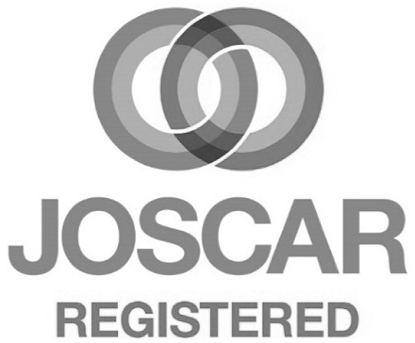G5-REGEN
Modular Regenerative DC Loads
G5-REGEN
Modular Regenerative DC Loads
With the ability to sink DC power up to high voltage and currents, the G5-REGEN is ideal for testing energy storage devices.
| Min | Max | |
|---|---|---|
| Power: | 0 to 18kW | 0 to 6MW This maximum is achieved by using units in master-slave. |
| Voltage: | 3 to 500VDC | 16 to 3000VDC Configurations >1500V are possible with a centre tapped earth. |
| Current: | 0 to 54A | 0 to 19440A This maximum is achieved by using units in master-slave. |
| Standard Control: | Analogue, Ethernet, USB |
|---|---|
| Optional Control: | Touchscreen HMI, CAN, EtherCAT |
or call 01246 452909 to discuss this product
Product Information
With the ability to sink DC power up to high voltage and currents, the G5-REGEN is ideal for testing energy storage devices. Modules are stackable to 6MW.
Each power dense module has an extensive feature set which includes programmable PID parameters and an inbuilt 8 channel recording scope. Adjustable power and resistance limits are provided. Optional remote control interfaces are available including high-speed CAN. Every G5-REGEN features an autoranging sink range, which allows for many more V/I combinations at nominal power. Modules can be fitted into flight cases or lab racks, with available options including isolation monitoring and emergency stops.
- Programmable Ripple up to 10kHz
- Two Current Ranges for Higher Accuracy
- Mixed Power Nominals in Master-Slave
- Optional Battery Emulation Software
- Ultra-Fast Dynamic Behaviour
- Sink Voltages up to 3000V
Technical Specifications
Modularity (Master/Slave)
Operating Ranges and Features
Operating Modes
Interfaces and Control
Software/Soft Tools
APPLICATION SPECIFIC GUIs
Safety and Protection
Mechanical
Form Factor and Enclosures
Rental Systems
Product Applications
Selection Table
| Part Number |
Nominal Power | Voltage Range | Current Range | Internal Resistance Range | |
|---|---|---|---|---|---|
| G5-REGEN 18-500-108 | 18kW | 3 to 500VDC | 0 to -108A | 0 to 5000Ω | Add |
| G5-REGEN 18-1000-54 | 18kW | 5 to 1000VDC | 0 to -54A | 0 to 18000Ω | Add |
| G5-REGEN 27-500-162 | 27kW | 3 to 500VDC | 0 to -162A | 0 to 3000Ω | Add |
| G5-REGEN 27-1500-54 | 27kW | 8 to 1500VDC | 0 to -54A | 0 to 27000Ω | Add |
| G5-REGEN 36-500-216 | 36kW | 3 to 500VDC | 0 to -216A | 0 to 2500Ω | Add |
| G5-REGEN 36-1000-108 | 36kW | 5 to 1000VDC | 0 to -108A | 0 to 10000Ω | Add |
| G5-REGEN 54-500-324 | 54kW | 3 to 500VDC | 0 to -324A | 0 to 1500Ω | Add |
| G5-REGEN 54-1000-162 | 54kW | 5 to 1000VDC | 0 to -162A | 0 to 6000Ω | Add |
| G5-REGEN 54-1500-108 | 54kW | 8 to 1500VDC | 0 to -108A | 0 to 14000Ω | Add |
Frequently asked questions
Can't find what you're looking for? Ask us a question
Please fill out the form below and we will get back to you as soon as possible with an answer to your question.

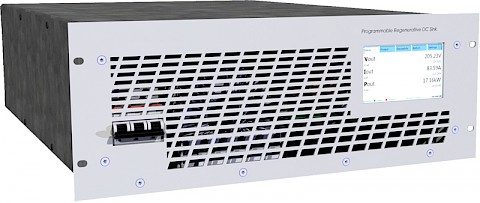
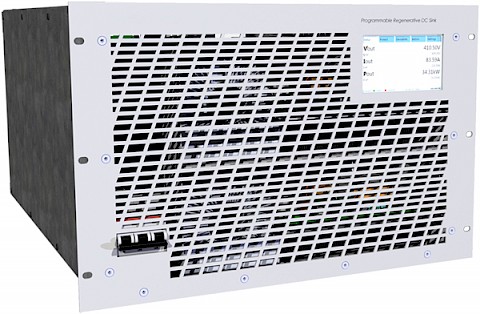
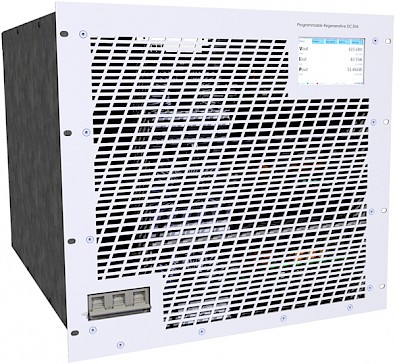
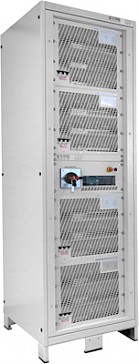

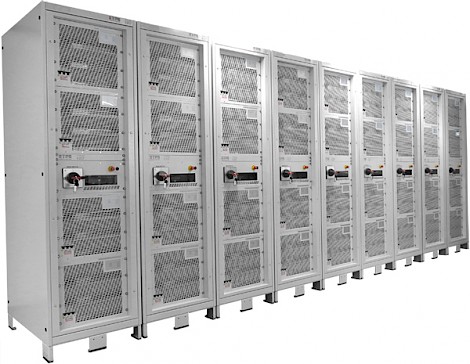
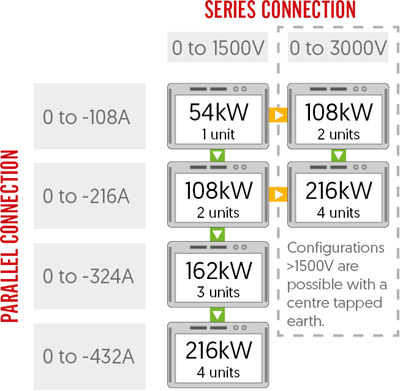 Up to 120 G5-REGEN modules can be arranged in series, parallel or matrix array configurations up to 6MW. Each module is able to operate independently, so that systems can be reconfigured, expanded or broken up as needs dictate. Inbuilt system comms allow users to switch between various set-ups. It is possible to connect models with different nominal powers in an asymmetric parallel configuration, as long as each module has the same nominal voltage. For example, an 18kW/500V/-108A and 54kW/500V/-324A module can be connected together to in parallel to create a 72kW/500V/-432A system.
Up to 120 G5-REGEN modules can be arranged in series, parallel or matrix array configurations up to 6MW. Each module is able to operate independently, so that systems can be reconfigured, expanded or broken up as needs dictate. Inbuilt system comms allow users to switch between various set-ups. It is possible to connect models with different nominal powers in an asymmetric parallel configuration, as long as each module has the same nominal voltage. For example, an 18kW/500V/-108A and 54kW/500V/-324A module can be connected together to in parallel to create a 72kW/500V/-432A system. 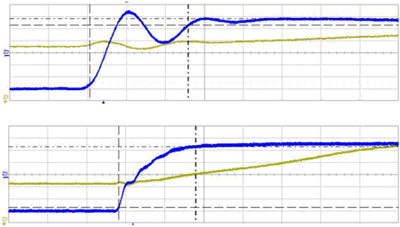 A current step between 0 to 90% IMAX can be as quick as 50µs, enabling high speed drives to be tested. Advanced users have access to the controller settings enabling the response to be optimised for particular loads. This example shows a current step through quadrants. The upper trace shows the current transition is achieved in 50µs with a small overshoot before settling. The lower plot shows a more regulated response within 200µs. Voltage typically takes 100µs to recover within 0.5% of the set value. In multi-module systems the communication time between modules need to be considered.
A current step between 0 to 90% IMAX can be as quick as 50µs, enabling high speed drives to be tested. Advanced users have access to the controller settings enabling the response to be optimised for particular loads. This example shows a current step through quadrants. The upper trace shows the current transition is achieved in 50µs with a small overshoot before settling. The lower plot shows a more regulated response within 200µs. Voltage typically takes 100µs to recover within 0.5% of the set value. In multi-module systems the communication time between modules need to be considered.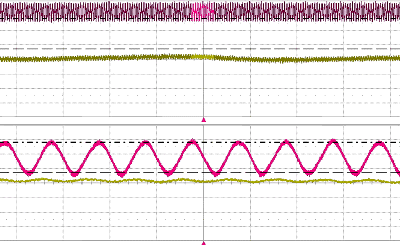 By utilising the optional embedded function generator the user can set a current ripple at up to 10kHz. The magnitude can be up to 5% of the nominal system current. Depending on the impedance of the DUT the resulting voltage ripple can be calculated. The below example shows a 10kHz ripple generated using the function generator of the G5-REGEN. A peak to peak current of 8A has been superimposed on a current of 100A. Alternatively, a ripple can be implemented from an external waveform generator via the analogue interface using a proportional 0-10V signal.
By utilising the optional embedded function generator the user can set a current ripple at up to 10kHz. The magnitude can be up to 5% of the nominal system current. Depending on the impedance of the DUT the resulting voltage ripple can be calculated. The below example shows a 10kHz ripple generated using the function generator of the G5-REGEN. A peak to peak current of 8A has been superimposed on a current of 100A. Alternatively, a ripple can be implemented from an external waveform generator via the analogue interface using a proportional 0-10V signal.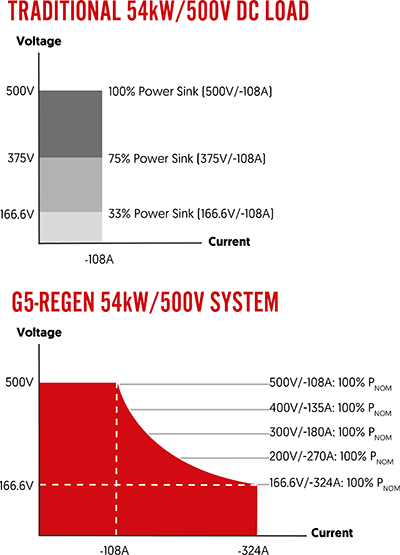 Every G5-REGEN features an autoranging DC sink range. This allows many more voltage/current combinations at nominal power than a traditional DC electronic load. An example of the difference is shown using a G5-REGEN 54-500-324.
Every G5-REGEN features an autoranging DC sink range. This allows many more voltage/current combinations at nominal power than a traditional DC electronic load. An example of the difference is shown using a G5-REGEN 54-500-324.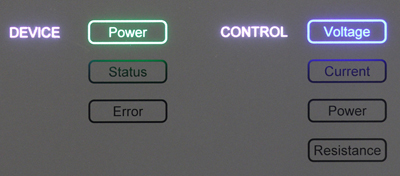 As standard the front panel has backlit indicators which illuminate to show which control mode the power system is operating in (CV, CC, CP, CR). When the G5-REGEN has been successfully energised, the corresponding power light illuminates green to indicate this. An illumination is also provided to visually warn users of any status (yellow) or error (red) message.
As standard the front panel has backlit indicators which illuminate to show which control mode the power system is operating in (CV, CC, CP, CR). When the G5-REGEN has been successfully energised, the corresponding power light illuminates green to indicate this. An illumination is also provided to visually warn users of any status (yellow) or error (red) message.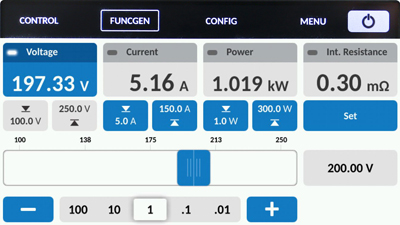 The optional HMI provides a simple and intuitive way of control and measurement via a touchscreen panel. Users can directly access features such as the system's protections, warnings/errors and optional function generator without the use of a computer. A user defined passcode can be set to lock the touch screen, which prevents unauthorised access. When selected, the HMI replaces the front panel indicator.
The optional HMI provides a simple and intuitive way of control and measurement via a touchscreen panel. Users can directly access features such as the system's protections, warnings/errors and optional function generator without the use of a computer. A user defined passcode can be set to lock the touch screen, which prevents unauthorised access. When selected, the HMI replaces the front panel indicator.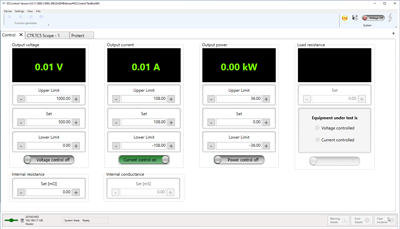 All G5-REGEN units come with a simple and intuitive G5.Control operating GUI as standard. Live values of the power system are displayed graphically along with any warning and error messages. The software provides a variety of second level parameters, ideal for users who like to optimise their test processes. In standard user mode the operator can remotely program set values, enable voltage output as well as the ability to analyse different variables including set and actual values via the integrated scope.
All G5-REGEN units come with a simple and intuitive G5.Control operating GUI as standard. Live values of the power system are displayed graphically along with any warning and error messages. The software provides a variety of second level parameters, ideal for users who like to optimise their test processes. In standard user mode the operator can remotely program set values, enable voltage output as well as the ability to analyse different variables including set and actual values via the integrated scope.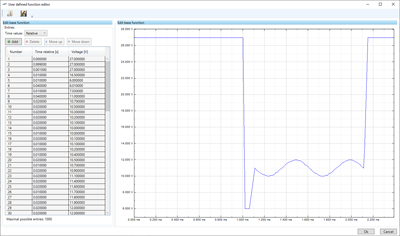 Complex DC waveforms can be implemented through an optional embedded function generator. The highly programmable nature of the function generator allows users to plot out exact waveforms. This is often advantageous when emulating a power device with a very specific behaviour profile. For example, when quality testing fuel cells, a specific behaviour waveform for discharging the fuel cell can be programmed and replicated.
Complex DC waveforms can be implemented through an optional embedded function generator. The highly programmable nature of the function generator allows users to plot out exact waveforms. This is often advantageous when emulating a power device with a very specific behaviour profile. For example, when quality testing fuel cells, a specific behaviour waveform for discharging the fuel cell can be programmed and replicated.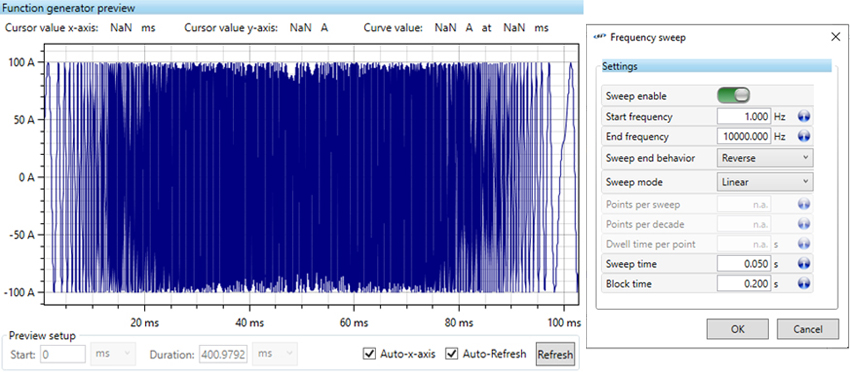
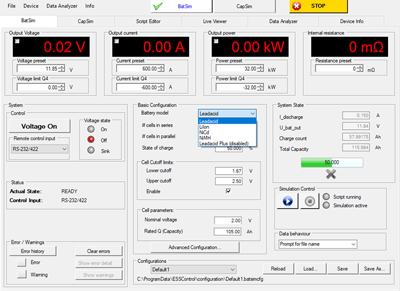 BatSim is a battery emulation GUI for use with G5-REGEN power systems. The GUI allows the electronic loads to simulate real world behaviour of a battery pack.
BatSim is a battery emulation GUI for use with G5-REGEN power systems. The GUI allows the electronic loads to simulate real world behaviour of a battery pack.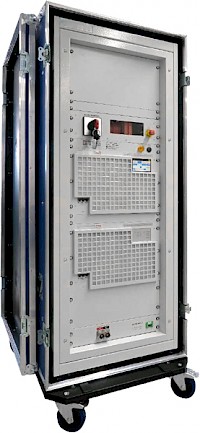 The G5-REGEN modules are designed to be operated within a clean laboratory environment. If there is the possibly that the environment will be less clean, then the optional front panel frame and air filter arrangement offer some additional protection. The standard filter material is rated in class G3. This class is effective at trapping a high proportion (90%) of particles ≥10um according to EN 779.
The G5-REGEN modules are designed to be operated within a clean laboratory environment. If there is the possibly that the environment will be less clean, then the optional front panel frame and air filter arrangement offer some additional protection. The standard filter material is rated in class G3. This class is effective at trapping a high proportion (90%) of particles ≥10um according to EN 779. 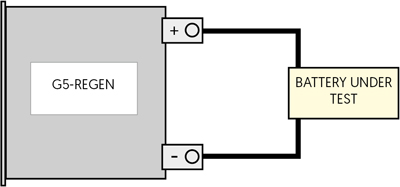 A potential side effect of charger circuits that contain both AC and DC components is electrical noise. The ripple causes unwanted fluctuations in battery temperature, which results in deterioration of the battery’s performance. By utilising the G5-REGEN's optional embedded function generator the user can set a current ripple at up to 10kHz to simulate this phenomenon.
A potential side effect of charger circuits that contain both AC and DC components is electrical noise. The ripple causes unwanted fluctuations in battery temperature, which results in deterioration of the battery’s performance. By utilising the G5-REGEN's optional embedded function generator the user can set a current ripple at up to 10kHz to simulate this phenomenon. 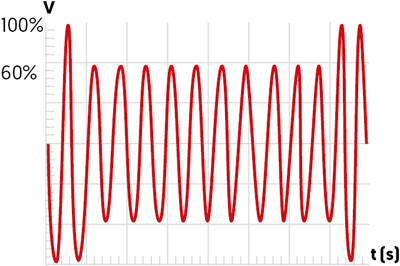 In electronic systems sudden voltage interruptions may cause unexpected behaviour. Supply line disturbances may have several causes, including an additional switch on of large capacitive loads parallel to the supply line or a short circuit caused by loads sharing the supply. The G5-REGEN can generate many complex DC waveforms to test devices under realistic conditions to identify any potential issues.
In electronic systems sudden voltage interruptions may cause unexpected behaviour. Supply line disturbances may have several causes, including an additional switch on of large capacitive loads parallel to the supply line or a short circuit caused by loads sharing the supply. The G5-REGEN can generate many complex DC waveforms to test devices under realistic conditions to identify any potential issues.  Virtually any DC operating waveform can be replicated using the G5-REGEN. The influence that variables, such as line voltage variation, have on performance can be isolated and tested. This allows optimum operating conditions to be characterised to improve efficiency and performance.
Virtually any DC operating waveform can be replicated using the G5-REGEN. The influence that variables, such as line voltage variation, have on performance can be isolated and tested. This allows optimum operating conditions to be characterised to improve efficiency and performance. The discharge behaviour of an FCEV's fuel cell is often irregular. By using the function generator, both conservative and aggressive driver profiles can be replicated. This allows the G5-REGEN to perform effective quality testing of fuel cells under all likely operating conditions.
The discharge behaviour of an FCEV's fuel cell is often irregular. By using the function generator, both conservative and aggressive driver profiles can be replicated. This allows the G5-REGEN to perform effective quality testing of fuel cells under all likely operating conditions.